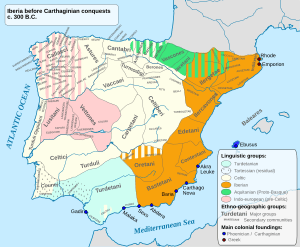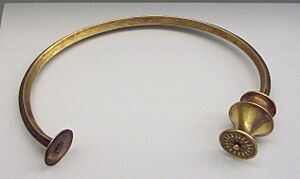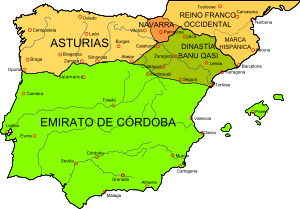Astures facts for kids
The Astures were an ancient people who lived in the northwest part of what is now Spain and Portugal. They were part of the Celtic group and spoke a Celtic language. Their homeland included most of modern Asturias, parts of León, and northern Zamora in Spain. They also lived in eastern Trás os Montes in Portugal.
The Astures were known for riding horses and raising cattle in the highlands. They lived in round huts made of stone. One important group among them was the Albiones, who lived in western Asturias. Some historians believe their name came from a river called Asturia, possibly the Órbigo River or the Esla River.
Contents
Where They Lived
The Astures lived in the modern region of Asturias and parts of León, Lugo, Ourense, and northern Zamora provinces. They also lived in the northeastern part of Trás-os-Montes in Portugal.
They had several important towns, including:
- Lancia (near Villasabariego – León)
- Asturica (Astorga – León)
- Mons Medullius (Las Medulas? – León)
- Bergidum (Cacabelos – León)
- Lucus Asturum (Lugo de Llanera – Asturias)
- Brigaetium (Benavente – Zamora)
- Nemetobriga (A Pobra de Trives – Ourense), which was an important religious center.
Their Beginnings
The Astures might have been part of an early movement of people from the Hallstatt culture in central Europe. They moved into Gaul and then crossed the mountains into Spain and Portugal. By the 6th century BC, they lived in hillforts called castros, like Coanna and Mohias.
The Romans divided the Astures into two main groups, based on the Picos de Europa mountains:
- The Transmontani lived "beyond" (north of) the mountains, in what is now Asturias.
- The Cismontani lived on the "near" side (south of) the mountains, in the area of León.
Before the Romans arrived, the Astures were united in a group of tribes. Their main capital was the hillfort of Asturica (Astorga).
Their Culture
Studies of old writings suggest that the Astures spoke a type of Celtic language similar to their neighbors, the Gallaeci. Even though the Celtic language was lost over time, many village and place names in the region still come from Celtic words. For example, Taranes is linked to the god Taranis, and Lugones to the god Lugus.
Ancient writers said that Asturian families were matrilineal. This means that women inherited property and land. The Astures lived in hill forts, which were strongholds built on hills. In mountainous areas, these forts had round walls. In flatter areas, they had rectangular walls, similar to the Galicians. Both men and women in their society were fierce warriors.
Religion
Many Asturian tribes, like the Lugones, worshipped the Celtic god Lugh. Other Celtic gods like Taranis and Belenos are still remembered in the names of places where the Astures lived. They might have also worshipped a local deity called Busgosu.
How They Lived
The Astures were strong highlanders who hunted and gathered food. They were known for sometimes raiding Roman outposts in the lowlands. Ancient writers like Florus and Paulus Orosius described them as very strong and independent people.
However, archaeological finds show that they also raised animals in mountain pastures. They also farmed on the slopes and in the valleys. They mainly kept sheep, goats, and some oxen. They also had a special breed of mountain horse called the Asturcon, which still exists today. These horses were small, graceful, and very fast. They were used for hunting and fighting in the mountains.
For much of the year, acorns were a main food source. They would dry and grind acorns into flour to make a type of bread that could be stored easily. From their small fields, they grew barley to make beer (called Zythos), as well as wheat and flax. Because they didn't grow a lot of food, and because they were warlike, they often raided the lands of the Vaccaei, who had more developed farms. The poet Lucan called them "pale seekers after gold," suggesting they also looked for gold.
Their History
The Astures first appeared in historical records in the late 3rd century BC. They were hired soldiers in Hasdrubal Barca's army during the battle of Metaurus River in 207 BC. Silius Italicus also mentions Asturian soldiers in Hannibal's army, led by a chief named Cydnus.
After the 2nd Punic War, their history is less clear. They were not often mentioned in records about the Lusitanian or Celtiberian wars. But they became important again just before the first Astur-Cantabrian war began in the late 1st century BC.
Led by Gausón, a former soldier, the Astures joined forces with the Cantabri people. They fought against the Roman Emperor Augustus's plan to conquer all of northwest Iberia. They even supported a failed revolt by the Vaccaei in 29 BC. The fight against the Astures and Cantabri was so difficult that Emperor Augustus himself had to come to lead seven Roman legions and a naval fleet.
The first Roman campaign against the Astures, called the Bellum Asturicum, started in the spring of 26 BC. It ended in 25 BC when the Astures at Mons Medullus surrendered to Augustus. This allowed Augustus to return to Rome and celebrate his victory. The Roman general Publius Carisius then forced Gauson and his remaining troops to surrender at the hillfort of Lancia. The Astures were defeated by the Romans, but their traditional way of life did not change much.
After this, the Asturian lands became part of the new Roman province called Provincia Transduriana. The Romans built military bases like Castrum Legio VII Gemina (León) and Petavonium (Rosinos de Vidriales – Zamora). They also founded Roman towns like Asturica Augusta (Astorga) and Lucus Asturum (Lugo de Llanera – Asturias).
Even with the harsh Roman rule, the Asturian region remained restless. There were occasional revolts, often with the Cantabri, and constant guerrilla warfare. This kept the Roman army busy until the mid-1st century AD. New uprisings happened in 24–22 BC, 20–18 BC, and 16–13 BC. These were all put down by Roman generals like Marcus Vipsanius Agrippa.
Roman Influence
The Asturian region became part of the Roman province of Hispania Tarraconensis. It was a slow process for the Astures to become like the Romans. They kept their Celtic language, religion, and much of their old culture throughout the Roman period. They also kept their fighting traditions. This allowed them to provide many cavalry and infantry units to the Roman Army. These units fought in Emperor Claudius's invasion of Britain in AD 43–60. They continued to serve in the Roman army for a long time.
However, writings on stone show that the Astures rebelled again in AD 54. This led to another fierce guerrilla war that lasted for fourteen years. The situation finally became calm around AD 68.
The Early Middle Ages
During the Germanic invasions in the late 4th century AD, the Astures fought against raids by the Suevi and Visigoths throughout the 5th century AD. They were eventually defeated and became part of the Visigothic Kingdom in the early 6th century AD.
But the Astures continued to rebel. King Wamba had to send an army to the Asturian lands just twenty years before the Muslim invasion of the peninsula. After the Visigothic kingdom fell, the Astures chose Pelagius of Asturias as their leader. They then formed the Kingdom of Asturias.
Their Legacy
Later, at the start of the Reconquista period in the early Middle Ages, the name of the Astures lived on. It was used for the medieval Kingdom of Asturias. It also lives on in the modern town of Astorga, León. This town's name still comes from its old Roman name, Asturica Augusta, which meant "the Augustan settlement of the Astures."
See also
 In Spanish: Astures para niños
In Spanish: Astures para niños
- Leonese people
- Asturian people
- Astur-Cantabrian Wars
- Castro culture
- Gallaecia
- Eonavian
- Gausón
- Pre-Roman peoples of the Iberian Peninsula
- Leonese language





